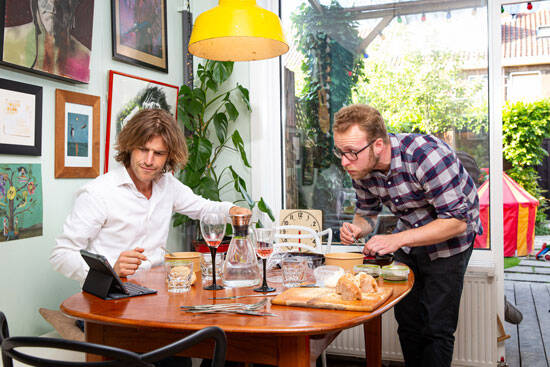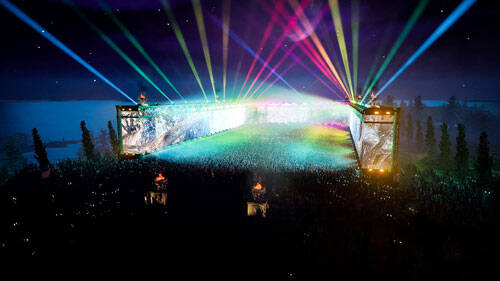© Nurtu.re

© Nichon Glerum

© Tomorrowland


Foodservice and media entertainment are beginning to blend. The digitalization of the world at large has taken flight during the pandemic, and foodservice is being forced to adapt to shifting paradigms. We’re moving to a broader definition of hospitality, where sometimes the experience trumps the food. A scary change, but foodservice is uniquely positioned to thrive in this new avenue. Because what are we looking for in the digital space? Human connection. No other industry does the human touch better than foodservice, and adapting to a new medium is a lot easier than having to learn how to connect people. Foodservice will change, but even in this new reality, restaurants will remain an essential part of people’s lifestyle.
A broader definition

Livestreaming is big. However, for restaurants and foodservice that relies on that ineffable atmosphere and the obvious presence of actual food moving your medium online poses serious challenges. There are a few lessons to be learned from festivals and other hospitality-adjacent events, which have seen great success moving virtual. Club Quarantine in Berlin, for example, captured the Berlin nightlife in virtual reality complete with dance floor, light shows, and music acts. With just 3 events, they attracted 700,000 virtual visitors. Even for a digital event, they were over capacity, with 40,000 guests happily waiting for their chance to virtually let loose. Similarly, virtual music festival Tomorrowland drew more than a million viewers for their online only edition. What does this have to do with restaurants? Well for all their sonic spectacle these virtual festivals didn’t have any food or drink. On a local level, creative partnerships with music venues and delivery services can create full fledged hospitality experiences for guests at home. Not unlike blended events that are proving popular in the business world. With these blended events, the staff and speakers are present on location, but the audience follows from home. In a restaurant, you could give guests a view from the kitchen, or a conversation with the chef and sommelier. Similarly, the staff could provide service from a distance, explaining each dish as the guest eats it at their own dinner table.
The virtual restaurant

Sustainability
While convenience and efficiency kind of speak for themselves, sustainability still needs to be communicated. What’s your business doing to make the world a better place? How can you use technology to show your efforts? Being as transparent as you can is a big boon, and not terribly difficult most of the time. Are you working with local suppliers? Get them on video or organize a digital roundtable so guests can see you care and are taking the right steps.
Convenience
Digital ease of use has become self-evident in every other area of our lives, and digital interactions with restaurants need to follow suit. This can be as easy as a mobile app for placing online orders instead of a phone call, or as creative as you can think of. An app has the added advantage of tracking preferences and potential seamless integration with existing point of sale systems.
Efficiency
Will technology make your operations faster, better, cost-efficient and more profitable. Competition is fierce, and with the devastating impact of COVID-19 on consumers’ spending power lower prices are an attractive option. Be careful not to sacrifice quality for efficiency though. Having a robot in your kitchen is awesome, but if it makes lesser quality food than human hands, it might not be worth it in the long run.
Tech adoption: from nice to have to need to have
Hospitality is going high-tech, and standing out in a digital world means you need to excel in three pillars of high-tech hospitality: convenience, efficiency, and sustainability.
The human touch is the essence of hospitality. Making a meaningful connection, however brief, is a large part of why 60 percent of US adults consider restaurants an essential part of their life. The pandemic has isolated people everywhere, making these moments of connection more important than ever. But, with lockdowns, stay-in-place orders, and general anxiety about any kind of in-person gathering, many turn to the digital space for these connections. Future-proof hospitality concepts need to follow suit. Maintaining the human touch at a distance is difficult, but not impossible, and fortunately technology is here to help. Specifically in the form of data. It has never been easier to know what your guests want and are looking for in your business. The best time to start a database to keep track of your guests’ preferences is yesterday. What did they order last time they were here? What’s their favorite drink or special occasion? People are dining out less, so every moment of in-person connection counts double. Knowing more about the people you serve will help you create not just returning guests, but lifelong fans.
What is the food system missing?


There’s no way around it: foodservice is going digital. While we can’t quite taste or smell through our screens just yet, the digital space has become an invaluable resource for restaurants and foodservice over the world. With many restaurants still faced with the reality of the COVID-19 pandemic, finding an online audience and forging connections from a distance is more important than ever. For some, it could mean the difference between recovering and going under. What can you do?
Jelle Steenbergen Xiao Er Kong

Foodservice in a digital space
trendwatch
4 min
embracing the new virtual reality






© Tomorrowland

© Nichon Glerum

© Nurtu.re


Foodservice and media entertainment are beginning to blend. The digitalization of the world at large has taken flight during the pandemic, and foodservice is being forced to adapt to shifting paradigms. We’re moving to a broader definition of hospitality, where sometimes the experience trumps the food. A scary change, but foodservice is uniquely positioned to thrive in this new avenue. Because what are we looking for in the digital space? Human connection. No other industry does the human touch better than foodservice, and adapting to a new medium is a lot easier than having to learn how to connect people. Foodservice will change, but even in this new reality, restaurants will remain an essential part of people’s lifestyle.
A broader definition
Livestreaming is big. However, for restaurants and foodservice that relies on that ineffable atmosphere and the obvious presence of actual food moving your medium online poses serious challenges. There are a few lessons to be learned from festivals and other hospitality-adjacent events, which have seen great success moving virtual. Club Quarantine in Berlin, for example, captured the Berlin nightlife in virtual reality complete with dance floor, light shows, and music acts. With just 3 events, they attracted 700,000 virtual visitors. Even for a digital event, they were over capacity, with 40,000 guests happily waiting for their chance to virtually let loose. Similarly, virtual music festival Tomorrowland drew more than a million viewers for their online only edition. What does this have to do with restaurants? Well for all their sonic spectacle these virtual festivals didn’t have any food or drink. On a local level, creative partnerships with music venues and delivery services can create full fledged hospitality experiences for guests at home. Not unlike blended events that are proving popular in the business world. With these blended events, the staff and speakers are present on location, but the audience follows from home. In a restaurant, you could give guests a view from the kitchen, or a conversation with the chef and sommelier. Similarly, the staff could provide service from a distance, explaining each dish as the guest eats it at their own dinner table.
The virtual restaurant



Hospitality is going high-tech, and standing out in a digital world means you need to excel in three pillars of high-tech hospitality: convenience, efficiency, and sustainability.
Sustainability
While convenience and efficiency kind of speak for themselves, sustainability still needs to be communicated. What’s your business doing to make the world a better place? How can you use technology to show your efforts? Being as transparent as you can is a big boon, and not terribly difficult most of the time. Are you working with local suppliers? Get them on video or organize a digital roundtable so guests can see you care and are taking the right steps.
Convenience
Digital ease of use has become self-evident in every other area of our lives, and digital interactions with restaurants need to follow suit. This can be as easy as a mobile app for placing online orders instead of a phone call, or as creative as you can think of. An app has the added advantage of tracking preferences and potential seamless integration with existing point of sale systems.
Efficiency
Will technology make your operations faster, better, cost-efficient and more profitable. Competition is fierce, and with the devastating impact of COVID-19 on consumers’ spending power lower prices are an attractive option. Be careful not to sacrifice quality for efficiency though. Having a robot in your kitchen is awesome, but if it makes lesser quality food than human hands, it might not be worth it in the long run.
Tech adoption: from nice to have to need to have
The human touch is the essence of hospitality. Making a meaningful connection, however brief, is a large part of why 60 percent of US adults consider restaurants an essential part of their life. The pandemic has isolated people everywhere, making these moments of connection more important than ever. But, with lockdowns, stay-in-place orders, and general anxiety about any kind of in-person gathering, many turn to the digital space for these connections. Future-proof hospitality concepts need to follow suit. Maintaining the human touch at a distance is difficult, but not impossible, and fortunately technology is here to help. Specifically in the form of data. It has never been easier to know what your guests want and are looking for in your business. The best time to start a database to keep track of your guests’ preferences is yesterday. What did they order last time they were here? What’s their favorite drink or special occasion? People are dining out less, so every moment of in-person connection counts double. Knowing more about the people you serve will help you create not just returning guests, but lifelong fans.
What is the food system missing?

There’s no way around it: foodservice is going digital. While we can’t quite taste or smell through our screens just yet, the digital space has become an invaluable resource for restaurants and foodservice over the world. With many restaurants still faced with the reality of the COVID-19 pandemic, finding an online audience and forging connections from a distance is more important than ever. For some, it could mean the difference between recovering and going under. What can you do?
Jelle Steenbergen Xiao Er Kong
Foodservice in a digital space

4 min











